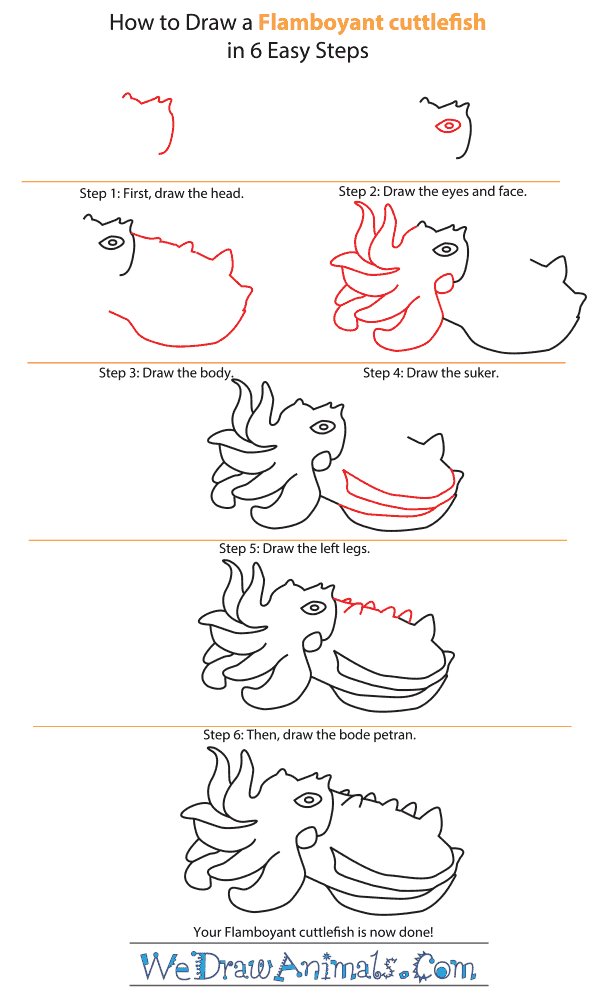In this quick tutorial you'll learn how to draw a Flamboyant Cuttlefish in 6 easy steps - great for kids and novice artists.
The images above represent how your finished drawing is going to look and the steps involved.
Below are the individual steps - you can click on each one for a High Resolution printable PDF version.
At the bottom you can read some interesting facts about the Flamboyant Cuttlefish.
Make sure you also check out any of the hundreds of drawing tutorials grouped by category.
How to Draw a Flamboyant Cuttlefish - Step-by-Step Tutorial
Step 1: Draw the head first. Make sure to add ridges in your drawing.
Step 2: On the upper right part of the face, draw the eye. Draw a small oval, and then a smaller circle inside.
Step 3: When drawing the body, make sure to leave an open space for the face on the left side. Add ridges on the back of the body to make it took realistic.
Step 4: The rest of the face consists of tentacles, which come from the left side.
Step 5: Now draw lines as shownon the bottom half of the animal
Step 6: Finally, add ridges to the back of the animal, similar to the ones in Step 3
Interesting Facts about the Flamboyant Cuttlefish
Flamboyant cuttlefish is mainly found in 3-86 m deep shallow waters of Indo-Pacific Ocean. They are brown in color and during a predator attack they can easily change their color to black, yellow, white and dark brown combination. They have yellow fins and purple arms with a yellow stripe. Its arms are sharp and wide with thin shielding outer membrane. There are papillae present on their rare side and above their eyes, which are big in size, flat in shape. The back surface is also covered with a thin layer of chitin. Flamboyant cuttlefish is diurnal in nature and uses camouflage to look for prey during the day. It feeds on crustaceans and fish.
Did you know?
- Flamboyant cuttlefish is not meant for consumption, as its muscle tissue contains deadly toxins.
- This is the only type of cuttlefish that walks on the sea surface.
- It can barely float because of its thick and small sized cuttlebone, which is present in all types of cuttlefish.
- The eggs are found to be white and opaque initially but gradually it turns translucent that allows clear visualization of the growth of a baby flamboyant cuttlefish.
- The presence of chromatophores, leucophores and iridophores, allow cuttlefish to easily switch colors.
- To mislead its predators, cuttlefish releases ink referred to as ‘Sepia’ that creates an ink cloud while the cuttlefish runs away for safety.
Lesson plan note: Teachers may show children videos of flamboyant cuttlefish defense online. This will help them understand their structure, features and behavior very well. Flamboyant cuttlefish are very interesting and different organisms in terms of their appearance to learn about and will serve as a great experience for them!







